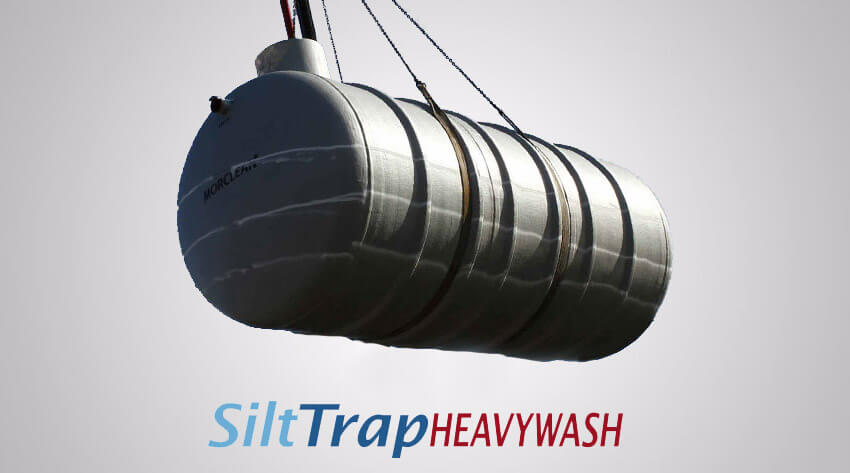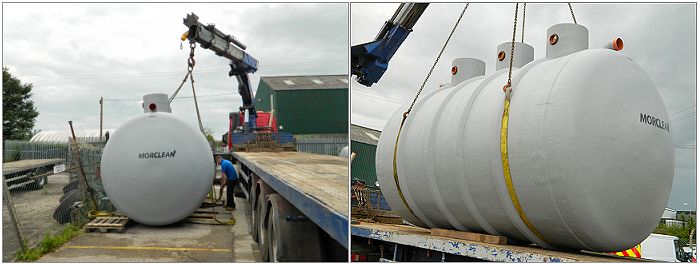Heavy Wash Silt Trap
This range of heavy wash slit traps are designed for heavy wash areas where levels of soils, debris and earth are high.
The Heavy Wash range of silt traps are typically used on wash bays for jetting earth moving equipment, quarry vehicles, open-cast or landfill where plant and machinery are covered in mud, clay or other debris.
The large 2m x 1m galvanised hinged grid provides a large surface area for debris to fall to the chamber, and allows access for emptying the sludge.


Available up to 20Cm3 capacity, the sludge trap contains silt prior to the interceptor and contains more than the average amount of debris contained in a standard silt trap. Available from 2,500 to 20,000 litre.
The additional access chamber is designed to be conveniently located under a standard 600mm cover and lid (not included).
Technical information and specifications available upon request.
Please note: This item requires frames and manhole covers
The above requires manhole cover(s) and lid(s) (not included). Due to the weights involved covers and lids are expensive to transport and often cost more to ship than they are worth so we advise you source your own. You can purchase covers and lids from most builders merchants and below is a guide to assist you choosing the best type for the duty.
| Type | Size (mm) | Duty | European Standard | Loading | Typical Overground |
|---|---|---|---|---|---|
| Class A15 | 600 x 450 | Light | BS EN 124 | 3 tonne (approx) | Cars/Small Vans |
| Class B125 | Medium | 17 tonne (approx) | Cars/Small Commercial | ||
| Class D400 | Heavy | 38 tonne (approx) | Large Commercials/HGV |
About Heavywash Silt Trap
Click the PDF icon to view information about our Heavywash Use Silt Trap.
(927Kb)
The EA and SEPA Pollution Prevention Guidelines (PPG) which are jointly produced by the Environment Agency for England and Wales, the Scottish Environment Protection Agency, and the Environment and Heritage Service for Northern Ireland (Ref PPG3 / PPG13 / PPG4 / PPG 14) suggest that Class 2 wash bay silt traps and interceptors should be connected only to a mains foul drain, and Class 1 separators to surface drain.
The above assumes you have the consent to connect any outflow to a suitable drain as per the appropriate PPG Guideline. While we always endeavour to provide best advice and accurate information, it the responsibility of the client and/or landowner to comply with the law. Following any guideline doesn’t remove your responsibility to comply with the law and prevent pollution from your activities. Causing or allowing pollution is a criminal offence; compliance with any guidance isn’t a defence. You should make sure that the references to other sources of guidance are still current.
Extract from the Pollution Prevention Guidelines: PPG13
3. Requirements for all vehicle washing and cleaning activities
Activities that produce run-off from the vehicle onto the ground and use cleaning and valeting products should be carried out in areas that are clearly marked and isolated from surface water drainage systems, unmade ground and porous surfaces. These areas are called designated washing bays.
A designated washing bay should be designed so that run-off is:
- isolated using channels, gullies, gradient (fall on the surface) and kerbs
- directed to a silt trap or settlement tank to remove larger particles of silt and sediment
- either collected in a sealed system for reuse, discharged to the public foul sewer with prior permission
- of the local sewer provider or collected in a sealed system for authorised disposal
You should also:
- have procedures for everyone, including contractors, that cover where and how vehicle washing and cleaning should be carried out and what to do in a spillage emergency
- provide notices for designated washing bays saying what they’re for and that washing and cleaning should only be carried out in the bay
- consider whether a fence or barrier is required to prevent spray or wind drift out of the designated area
- have procedures and equipment which minimises water use and solid waste production



